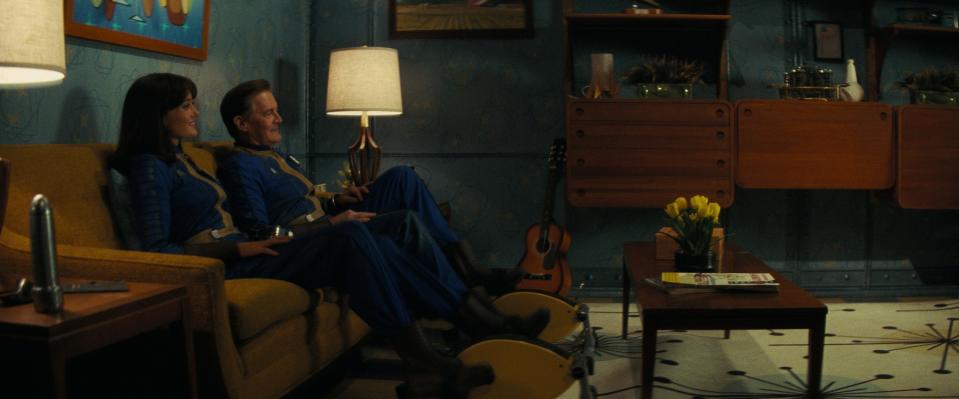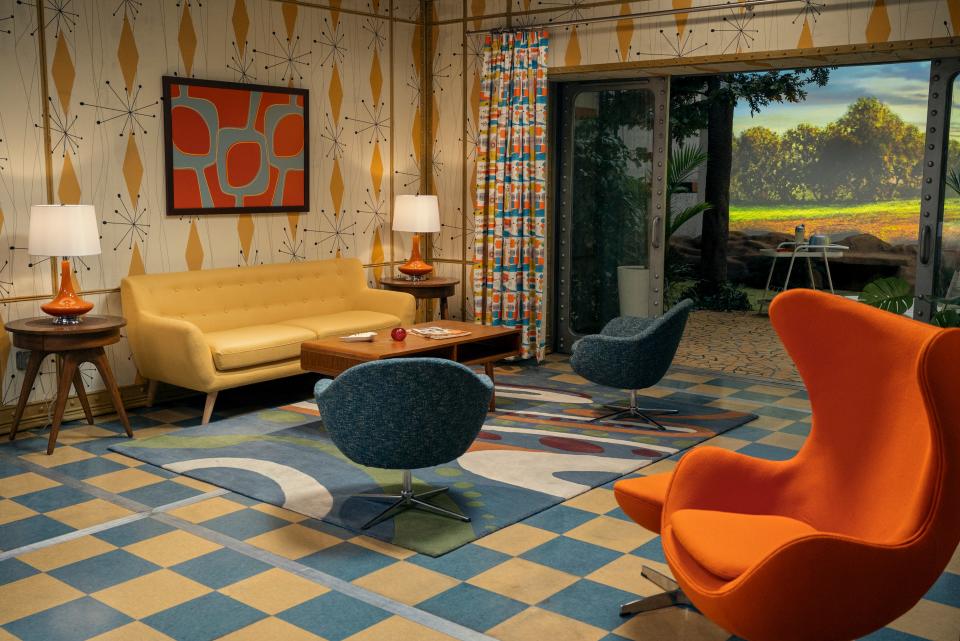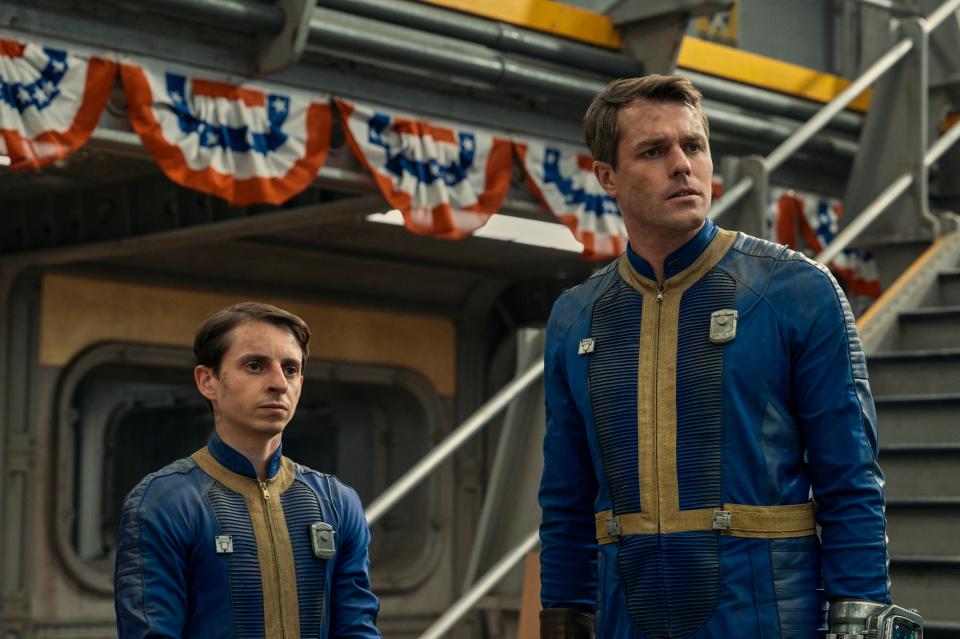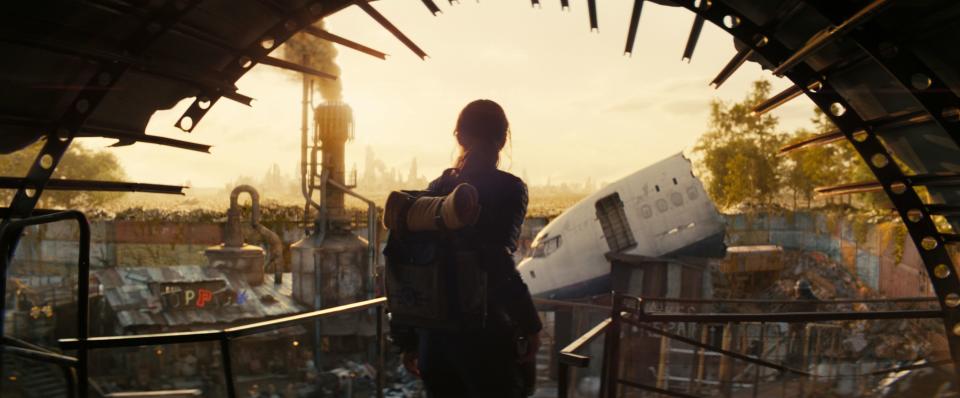In Fallout , Midcentury Modern Aesthetics Survive the Nuclear Apocalypse

Photo: Courtesy of Prime Video
Design lovers tuning into Fallout will be pleased to know that midcentury-modern style does indeed make it out of nuclear Armageddon intact. The new Prime Video series, which is an adaptation of the fan-favorite doomsday aftermath video games (the second such case from a major streamer in recent years, on the heels of HBO’s The Last of Us), divides its characters into camps of haves and have-nots following a cataclysmic nuclear event, which leaves behind only a scorched wasteland and some chic midcentury bunkers.
In 2296, the lucky live in a set of subterranean shelters known as the Vaults, where atomic age design reigns supreme centuries after its mid-20th-century IRL heyday. Everyone else has been hardened by the struggle of scavenging for resources in the irradiated no-man’s-land the US has devolved into. The series braids together three main narratives of characters from vastly different backgrounds when a tragedy draws charmingly naive protagonist Lucy, a vault dweller, up from her underground retreat to the barren badlands.

Fallout
Even in glimpses of the time before the big circa-2077 boom that kicks everything off, Fallout is not exactly the world as we know it; the series situates viewers in a Mad Men–esque future. Director/executive producer (and fan of the game) Jonathan Nolan tells AD that it’s a “bizarro America” based in the game’s alternate reality.
In Fallout’s version of US history, Nolan explains, “the Eisenhower era never ended. There was never Watergate, there was never Vietnam. There was never a moment of national self-reflection,” he says. “That nuclear-powered, swaggering America carried on for another 120 or so years, with nuclear-powered toasters, nuclear-powered this and that—and this is all the sensibility of the games.” Todd Howard, who led the development of the Fallout video games, also serves as an executive producer on the show. While the Prime series fashions its own original storylines, it excavates its rich source material to great effect when it comes to style.

Hondo
“I found out a lot [about the look the show could have] from going online—the fan base had already done YouTube tutorials and well-produced videos about it all. Everything we picked, somebody was going to analyze, because it all has its backstories that the storyline is so dense. I used to fall asleep listening to the history of the Brotherhood of Steel,” says production designer Howard Cummings, referring to the tech-focused organization of both the games and the show. Cummings and Nolan previously worked together on the sci-fi drama Westworld. While that HBO series deals in some similar techno-dystopian and Wild West aesthetics, Cummings describes it as a much leaner, more monochromatic kind of futurism as opposed to Fallout’s splashier, gamer-friendly look.

Hondo
Vault 33’s living quarters are a veritable time capsule of midcentury modern design. Perhaps most relevant to the plot at hand is the atomic age classic ball-and-stick motif. A rather literal take on the atom, the figure pops up throughout a range of midcentury-modern decor, like Sputnik light fixtures. Atomic technology created a sense of hope for improved quality of life and safety in post-war America, thus the scientific themes that inspired Americans began to seep into their home decor. The vibrant colors and patterns in Fallout’s vaults are quintessentially atomic age, though that midcentury style bleeds into a successor, space-age design, which is also folded into the show via pieces like metal spaceship-shaped trash cans.
“Cards on the table, you’re looking at two massive fans of midcentury,” Nolan admits, sharing that both he and Cummings live in SoCal midcentury homes. While Cummings says dwellings in the first scenes before the nuclear event were more “cookie-cutter suburban” abodes in the video games, the show’s production team felt compelled to choose a more cinematic statement piece for the dawn of the apocalypse. “We found this great house that was completely restored midcentury, the windows and doors were all original. It was basically a glass box house,” Cummings says. “So we didn’t always adhere to the game, but we did adhere to the aesthetic.”

Fallout
Another point of departure between the games and the show were the mock outdoor spaces crafted for the vault dwellers’ quarters, where a tidy turf lawn and fake greenery make a compact “outdoor” oasis. The setup looks out onto a screen projection of a sprawling field and tree line in the distance. They decided on including such areas in thinking about what someone who knew their great-great-great-great-great grandchildren might never live to see the light of day above would want out of a bunker. Details big and small were crucial in creating a world that felt as awe-inspiring, but also as considered and intricate, as the video games.
“In the games, you can climb the top of the tallest building, you could dig under the deepest underground layers of these cities, but it’s also microscopic: Every object, you can pick up, every book, you can read. It’s an incredible expanse,” Nolan says. “You’re not going to beat a video game with computer graphics, right? To give the audience that feeling of immersion that the games give the players, we knew we had to build real, practical vaults.”

Hondo
Usually on a set like this, Nolan says you’d “cheat it” by building one little hallway and redressing it for other shots. “We didn’t do any of that,” he says. “We built these massive, massive vaults.” A particularly satisfying bonus of physicalizing the universe Fallout game developer Howard helped design was watching him tour the sets and see the world he had imagined, brought to life.
“I remember watching him walk around the way I walked around his games, looking at the patina of the paint, this beautiful decay inside these tiles, where the special effects team hooked up little drip lines. It’s just incredibly beautiful,” Nolan says. “These are the most beautiful sets I’ve ever seen.”

Fallout - First Look
More beauty was borne from decay in sourcing materials for Filly, a surface dweller town that is canonically composed from scraps of the ravaged post-war LA area. The team found a gold mine in a New Jersey trash heap conveniently filled with period-appropriate refuse.
“I came upon this junkyard in New Jersey called Wade’s Salvage,” Cummings says. “It was started in the late ’40s and stopped in the ’60s. Everything in it was period correct to the show—not only that, the place was near a military base, so it also had a lot of military and jet parts and things. In this opening sequence, [Lucy approaches the settlement from] the woods, where there are all these 1940s cars. Those cars went in there in the ’40s and the forest grew up around them, just as if it was a parking lot when the bomb went off.”
![“There are several [raider villages of scrap material] in the game, so, we sort of pulled from different references from those,” Cummings says of the junkyard-sourced surface dweller settlement. “Megaton City is one of them, they’ve got crazy names.”](https://s.yimg.com/ny/api/res/1.2/PQyezDI_6wEFlpNwdXlqYg--/YXBwaWQ9aGlnaGxhbmRlcjt3PTk2MDtoPTY0MA--/https://media.zenfs.com/en/architectural_digest_422/6e97c8024c55b07553826f37f8ba0fb0)
Fallout
Sound stages in New York, a junkyard in New Jersey, and patches of Utah desert all served as shoot locations for the show, but in order to get the ruins of Santa Monica harbor just right, the team left the US behind for the Skeleton Coast of Namibia. The look of the shoreline was a perfect parallel to that particular stretch of California waterfront, sun-baked and empty as it would be after the Great War.
Lucy looks out onto the water and deteriorating ferris wheel after emerging from the vaults for the very first time. “The ferris wheel was the only thing we added in [digitally], everything else is real,” Nolan says.
“No one had ever shot there, except for a documentary about the local blind hyenas—they were wandering around, by the way. They’re blinded by the sandstorms,” Cummings says of the landscape, which earned its eerie moniker for the animal bones and shipwreck detritus littering its dunes. “It’s fantastic. It’s also super hard to shoot.” The conditions might’ve made for a few challenging days on set, but it wasn’t the end of the world.
Originally Appeared on Architectural Digest
More Great Celebrity Style Stories From AD
25 Years After Cruel Intentions, ’90s Noir Thrillers Are Still On Our Mood Board
Prentice Penny’s Maximalist Los Angeles Home Is All About Dreaming Big
Jeremiah Brent to Join Queer Eye Cast as Newest Member of the Fab 5
Step Inside Tan France’s Tudor-Style Dream House in Salt Lake City
Not a subscriber? Join AD for print and digital access now.
Browse the AD PRO Directory to find an AD-approved design expert for your next project.


